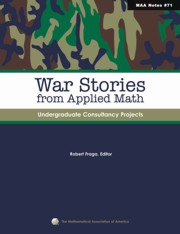Book contents
- Frontmatter
- Contents
- Introduction
- An Industrial Mathematics Program
- Source of Problems: Industrial Contacts
- Panel Discussion Following “Industrial Contacts”
- Course Integration
- The Consortium for Mathematics and Its Applications (COMAP)
- Program Management
- Project Deliverables I
- Project Deliverables II
- Using Projects from Industry to Teach Mathematics and Statistics to Liberal Arts Majors
- Mathematical Modeling in ICIC Projects
- Appendix: A Sample HMC Report
Program Management
- Frontmatter
- Contents
- Introduction
- An Industrial Mathematics Program
- Source of Problems: Industrial Contacts
- Panel Discussion Following “Industrial Contacts”
- Course Integration
- The Consortium for Mathematics and Its Applications (COMAP)
- Program Management
- Project Deliverables I
- Project Deliverables II
- Using Projects from Industry to Teach Mathematics and Statistics to Liberal Arts Majors
- Mathematical Modeling in ICIC Projects
- Appendix: A Sample HMC Report
Summary
I come from a different type of institution than other contributors to this book, and I want to point out that it is possible to do student consultancy projects without having the kind of institutional support that Bob Borrelli has. This chapter tells a little about the history of our projects and the way we manage the program. I also will give you some ideas on alternative management schemes.
In 1979, a small group of mathematicians at Towson decided that Claremont had a very good idea. We invited Jerry Spanier, then the Head of the Claremont Clinic, to come to Baltimore. Our institution is a public, state-supported, metropolitan, comprehensive university. We now have about 18,000 students, about 30% of whom live in dormitories or in apartments near campus. The average age of our students is about 25, but the variation is quite large. So we do have a fair number of non-traditional students. In the Mathematics Department we have several major tracks including applied mathematics, pure mathematics, secondary education, actuarial science, and double majors with computer science and with economics. There is a separate (and now rather large) Department of Computer and Information Sciences.
Towson University NSF Grant
In 1980, we received a grant from the National Science Foundation to begin our Applied Mathematics Laboratory. At the time we were the only school trying this type of student consultancy program with teams comprising only undergraduates. One of the reasons we started the program was to benefit our students who were leaving with degrees in pure mathematics but going into applied and industrial jobs.
- Type
- Chapter
- Information
- War Stories from Applied MathUndergraduate Consultancy Projects, pp. 67 - 80Publisher: Mathematical Association of AmericaPrint publication year: 2007

